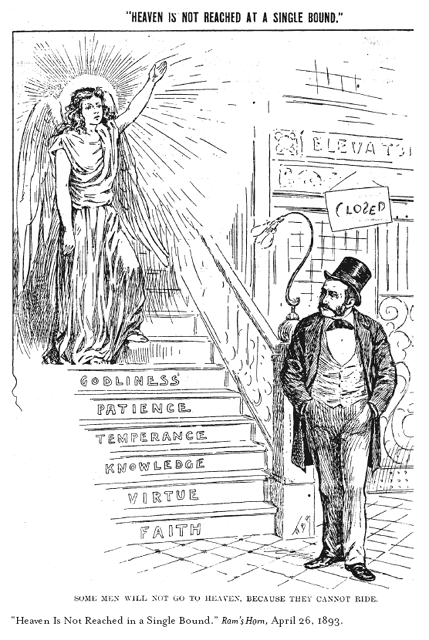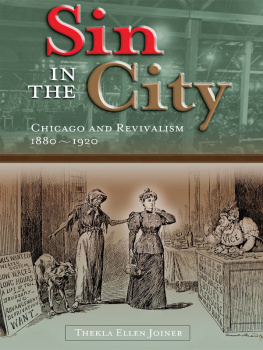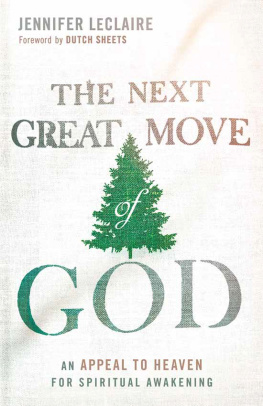ACKNOWLEDGMENTS
I am grateful for the numerous individuals and institutions that have contributed to the research and completion of this book. At the University of Illinois at Chicago, Jon Butler initially encouraged me to think about American religion. Leo Schlebert, Daniel Scott Smith, Margaret Strobel, and Michael Perman contributed to the book in its early stages. The interest and insightful questions from R. Stephen Warner were also very useful. The archivists and researchers at a variety of institutions have also helped in significant ways. The staff of the Chicago Historical Society, the Wisconsin State Historical Society, the Billy Graham Archive, the Moody Bible Institute, and the headquarters of the Woman's Christian Temperance Union answered questions and helped me locate the historical sources on which this book is based. McCormick Theological Seminary and several Chicago Presbyterian churches (Second and Fourth) graciously allowed me to examine their records.
While writing this book I was also teaching history at two institutionsCalifornia State UniversityLong Beach and Los Angeles Harbor College. Both brought me into contact with individuals who have encouraged my academic work. Sharon Sievers of Cal State Long Beach, along with Bradley Young, William Loiterman, Jim Stanbery, Harvey Siegel, King Carter, Gary Miller, David Weber, Bruce Lemon, Beverly Fridley, and Jonathan Lee from Harbor College have provided help and support. I am also indebted to the president of L.A. Harbor, Dr. Linda Spink, along with vice-president Luis Rosas and dean Nancy Carson for granting me a sabbatical that allowed me to finish the book. Kerrill Kephart also contributed very timely editorial comments that kept the book on the right path.
My personal support network of friends and family are also very valuable. My friends: Judy Haenn, Jan Rife, Lois and Brian Theissen-Love, Joan and Joel Sheesley, Mary and Brian Stein-Webber, Beth and David Brokaw, Pamela and Dave Clausen, Marion and Daniel Park, and Gerald Arata. Family members have also kindly tolerated my historical pursuitsMary and John Jauchen, Cherie and David Root, Amy and David Safley, Elysia and Nathan Root, as well as my mother, Josephine Joiner, and my in-laws, Ruth and Paul Caldwell. My husband, John Caldwell, has also provided immeasurable encouragement and support. My children, Otis, Julia, and Stephen, perhaps deserve the most thanks. Their constant patience, good humor, and love make me very happy to be their Mom. The book is dedicated to them.
CHAPTER 1
True Christianity in the Second City
CHICAGO EVANGELICALS
By 1890 Chicago had emerged as America's second city. As the largest city in the developing West, Chicago's grain, lumber, meatpacking, and farm implement industries spurred the city to unparalleled success in both manufacturing and shipping. Canals and then railroads positioned the city as an intermediary between the East and the West, a gateway city that tied the western hinterland's farms and small towns to the economies of the Northeast, particularly New York. The 1871 Chicago Fire only affirmed the city's dynamic potential. Even though the fire destroyed twenty-five hundred acres with financial losses topping $250 million, the city had, in the course of two years, rebuilt itself. According to many of the city's boosters, the fire's destruction had been a blessing in disguise. By burning away the conglomeration of buildings at the city's center, the inferno had encouraged the rise of a new Chicago, a more modern, vital city, well organized and complete with skyscrapers. The city's rebound from the fire also reinforced its can do image. Despite the horrific scenarios of the fire, the railroads continued to run, products continued to move, and the city continued to grow.
Chicago's keen ability simultaneously to process, market, and transport goods contributed to her position as a retail-wholesale giant. By initiating a new association between the city and its hinterlands, wholesalers like John V. Farwell and Company, Field, Leiter, and Company, and Potter Palmer increasingly replaced eastern suppliers and created financial networks based on buying and selling. This Chicago system epitomized capitalist modernization and quickly established the city as an important retailer in her own right. The city's dominant position in sales was equaled by its role as manufacturer. The initial centerpiece for Chicago's manufacturing sector was the McCormick Reaper Works, but the steel and lumber industries, in addition to meatpacking and grain processing, also contributed to Chicago's explosive growth.

Evangelicals and the Second City
By the 1870s and 1880s, the success of both the wholesale and manufacturing sectors generated a wave of wealthy Chicago elites. This group was actually the second group of entrepreneurs to emerge from the city's burgeoning economy. The first wave of Chicago capitalists had benefited from the city's earliest speculative environment in the 1830s and 1840s. First-wave leaders, such as land developer William Ogden, had also actively engaged in city governance. The later wave of entrepreneurs, such as Potter Palmer, Marshall Field, and George Armour, achieved even greater levels of wealth and held social positions that were unrivaled in the Midwest and the nation. Unlike their predecessors, the later group of business leaders disengaged from politics and instead attended strictly to business, linking their own personal success to civic improvement. This group chose to influence the city's direction through private means, such as churches, civic clubs, and private charities.
Protestant evangelicals were represented in both elite groups. Cyrus McCormick, Sr., was part of Chicago's original elite. One biographer of the McCormick family described the elder McCormick as a John Knox Presbyterian, whose ambitions in life were to make all the harvesting machines that were madenot one less, and to wage a one-man campaign for Old School Presbyterianism against both the schismatic forces of Higher Criticism and the new theology of liberal Presbyterianism.
Other Protestant evangelicals embraced Chicago's capitalist ethos. Turlington W. Harvey was a lumber magnate and prominent evangelical. In fewer than twenty years, Harvey rose from an apprentice sash-maker to the owner of several lumberyards in the city. Harvey then vertically integrated his lumber holdings, buying Michigan forests, processing mills, and a steel car company to transport lumber to Chicago for finishing. The Chicago Fire only accelerated Harvey's success. While the city still reeled from the fire's massive destruction, Harvey (whose lumberyard had been miraculously saved from the blaze) began immediate construction on residential housing. Later, in 1888, he and his associates built the town of Harvey, Illinois, one of Chicago's first dry suburbs. Harvey's success in lumber positioned him for membership in an elite network of governing boards and trustees that influenced the city's finances. Harvey served as a director of Chicago's These elites either instigated or oversaw what has been described as a second wave of industrial capitalism, a period of intense industrial concentration and reorganization leading to large Gilded Age corporations controlled by a few industrialist magnates.








